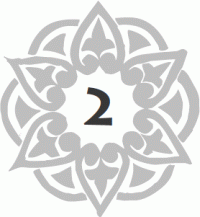

This chapter deals with increasing the availability of our own energies to do things. That is important to many of us who have MS, because often at some time during the day our energy runs out. On some days we wake up in the morning without much vim. The poses in this chapter help with the very simple, gentle process of bringing oxygen into the body, making more oxygen available to the cells, thus promoting metabolism and enabling us to be more active. The poses are intended to enhance the circulation of blood, stimulate the nervous system, and increase range of motion in shoulders, spine, and hips.
If at any time during these movements your body starts to tremble or shake, then please stop, take a breath, and wait until the tremor stops. Then start again.
Upward Hand Pose
1. Sit in a wheelchair with the back of the torso away from the back of the chair, if possible, or place a rolled sticky mat or blanket between the shoulder blades and the back of the chair to maintain a lifted spine and chest.
2. Place a strap around the arms, slightly above the elbows, with the buckle away from the flesh of the arm.
3. Extend the arms forward at shoulder height, with the palms facing each other.
4. On inhalation, raise the arms up. Bring them even with the ears, and rotate the biceps to the outside. This will enable the shoulder blades to support the back of the ribs.
If you are using an assistant, he must first rotate the biceps away from the ears, then gently encourage the shoulders to descend away from the ears. Then he may place his hands just above the strap at the elbows, and with a lifting motion encourage the elbow joint to open from the inside to the outside, in order to fully extend the arm.
5. Hold for three to four breaths, and then return the arms to the starting position.
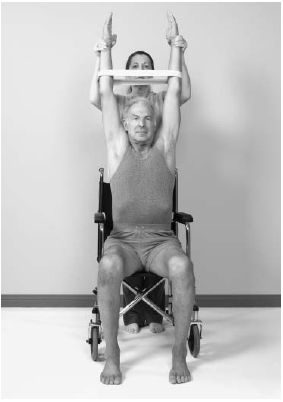
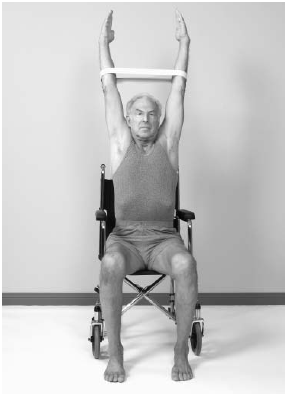
Warrior Pose II
1. Sit safely forward in a wheelchair.
2. Separate the thighs, with feet flat on the floor. Bend the right knee 90 degrees. Fully straighten the left knee.
3. Make a small loop at one end of a strap. Insert the right hand or thumb, keeping the buckle free.
4. With your left hand, grasp the strap behind the left side of your neck.
5. Stretch the arms apart. Simply slip the strap through your left hand until it is taut.
6. Lift the chest and back waist. Hold this position for a few breaths. Then slowly lower your arms. Sit quietly. Then repeat on the left.
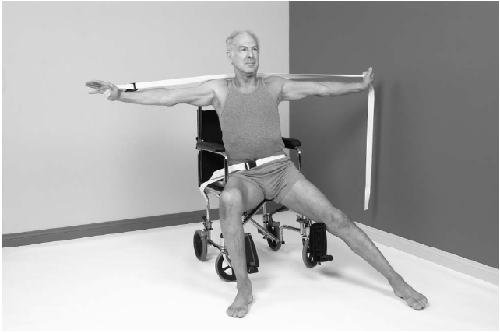
Strengthens and stretches legs, torso, and arms. Relieves thigh and calf cramps, and revitalizes abdominal organs.
Wheelchair Lateral Twist
This is a variation on Warrior Pose. The instructor can stabilize the arms by supporting the wrist bones, as the practitioner turns first the abdomen, then the sternum, and finally the shoulders.
1. Take the strap and again lace it around the hand or thumb. Start at the
navel or the center of the abdomen, keep the legs firm, and turn the chest with the shoulder. Hold the arms horizontally, and breathe comfortably for 3 to 5 breaths. Keep your nose and sternum in line, without tightening the clavicles (collarbones), shoulder blades, ears, face, or eyes.
2. Inhale as you untwist back to the center. Then turn and repeat on the left.
Once again, the breath comes in from the base of the nostril and out of the tip of the nose, reaching into your center with the force of each inhalation. The inhalation should charge the chest, and the exhalation should descend into the legs.
Improves hip and lumbar range of motion; counters abdominal cramps and constipation; plus benefits of untwisted Virabhadrasana II.
WHEELCHAIR ADHO MUKHA SVANASANA
Downward-Facing Dog Pose
1. Align the wheelchair securely against a wall. If needed, secure the safety belt.
2. Put your feet directly under the knees.
3. Place your palms on the seat of the chair.
4. On the inhalation, raise the top of your head, keeping the chin parallel to the floor.
5. Release the shoulders away from the ears. Exhaling, push the chair forward, and press the hips back.
6. On the next exhalation, push the chair forward to bring your arms in line with your ears.
7. Continue to press the hips back, press the heels down, lift the inner elbows, and press the palms and fingers firmly into the chair seat.
8. Try to move the breath from the low back around the ribs into the front of the sternum, allowing the abdomen to remain soft and free of pressure. After completing 3 to 5 inhalations and exhalations, return to an upright position, place the hands on the top of the legs, and breathe slowly and evenly.
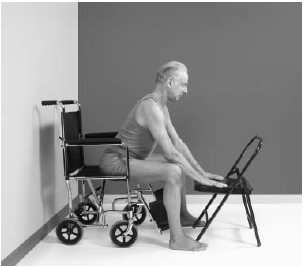
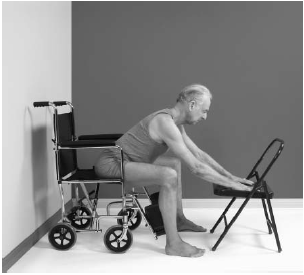
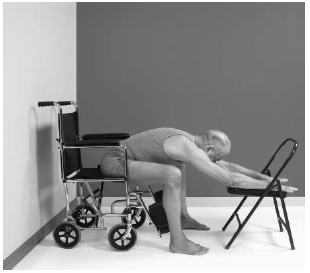
This pose aids digestion, reduces gas, engages lower back muscles, relieves discomfort from long periods of sitting, realigns the thoracic spine, and reduces tension in the shoulders and neck. It can be used to reduce stress and anxiety by calming the frontal brain.
WHEELCHAIR PARSVA ADHO MUKHA SVANASANA
Sideward Downward-Facing Dog
1. Align your wheelchair securely with its back against a wall. Be sure the safety belt is in place if one is needed. Move the yoga chair to the right outside the knee.
2. Place your palms on the seat of the chair, keeping the knees in alignment with the hips. Stretching the left arm slightly more than the right, keep the left hip pressed into the chair seat.
3. Push the chair diagonally to the right on an exhalation. Hold the position and breathe smoothly and evenly for 3 to 5 breaths.
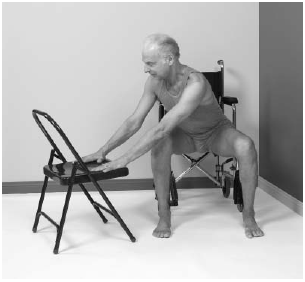
4. Return to the sitting position with the next inhalation. Lift the crown of the head, sit quietly, and then repeat on the other side.
This pose is an aid to digestion, it engages the lower back muscles, and realigns thoracic spine, neck, and shoulders. It enhances the circulation of blood to the liver, kidneys, spleen, pancreas, intestines, heart, and lungs, allowing more oxygen to flow toward the brain and prompting the bowel to empty.
WHEELCHAIR ADHO MUKHA SVANASANA AT WALL
Downward-Facing Dog Pose at Wall
1. Place your chair facing the wall, so that the knees are near the wall, with the feet slightly behind the knees, to gently stretch the Achilles tendon and the thigh muscles.
2. Then place the hands as high up on the wall as possible. Keep the arms in line with the ear canals, opening the outer edge of the armpits as much as possible.
3. Then rest the forehead on the wall, and allow the eyes to drop in to the cheekbones.
4. Press the hips back into the chair seat, and lift the bottom edge of the sternum, allowing the diaphragm to drape softly out to the sides of the rib cage.
5. Extend the fingers away from the palm of the hand; breathe normally for 3 to 5 breaths. Then lift the head and move the arms out to the sides of the torso.
6. Turn the palms up to rotate the shoulder blades inward to support the back and lungs. Then lower the arms to rest the palms on the thighs and breathe evenly.
This pose reduces tension in the low back, opens the chest and lungs to obtain more oxygen, engages the upper back and shoulders and neck, relieves tightness in the skull, and coordinates the digestive process. It increases hip joint range of motion, helps bowel elimination, and relieves pressure on the prostate gland. The pose also relieves pressure around and in the female reproductive organs. This is one of the essential asanas for those using wheelchair or walkers.
Sun Salutation
This adaptation of the classic Sun Salutation effectively works most areas of the body. This develops the ability to coordinate the breath with measured movement of the limbs and torso. This series of asanas is usually used as a warmup to a practice session. Caution: Resist the temptation to press the tongue against either the roof of the mouth or the lower palate. Keep the breath even and without effort. Try to move smoothly from one position to the next without hesitation. Remember, practice is the key to success.
1. Begin by bringing the hands up to rest in front of the heart, with the elbows raised
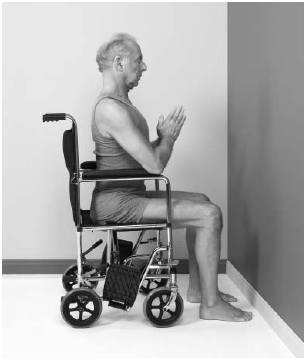
until they are parallel to the floor. Press the fingers together firmly, pointing slightly away from the chest.
2. Bring your feet to rest under the knees, distributing the weight from the balls of the big toes across the sole of the foot. Draw the outer edge of the foot back to the middle of the heel. Keep the knees in line with the hip joint.
3. Extend the arms forward, with the palms facing each other. If you have a shoulder joint problem, extend the arms out to the side with the palms facing up.
4. On the inhalation, bring your arms up alongside your ears.
5. On an inhalation, place your hands on the wall at shoulder height, drawing the wrists up and the shoulders down. At the same time, draw the right leg back outside the wheel of the chair and drop the right knee toward the floor.
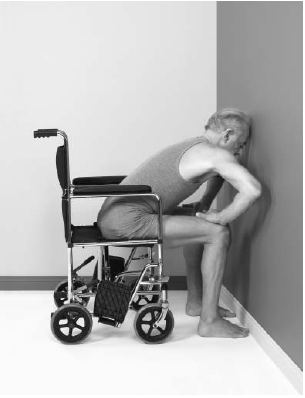
6. As you raise the lower right leg forward, grip both hands under the knee, and with an exhalation, lift the leg up sharply toward your chest.
7. Then with the next inhalation, place the right foot on the floor beside the left. Breathe smoothly, lift the back waist, and try to bring the inhalation into the sides of the chest.
8. On an exhalation, place your hands on the top of the knees, and press the elbows forward, as you rest the forehead against the wall.
9. Next, inhale and raise your arms out to the side with the palms facing up, continuing until you place your arms over your head, which still rests on the wall.
10. Press the palms firmly against the wall. Take several smooth breaths, extending the arms as much as possible and opening the sides of the chest and rib cage.
11. Swing the arms out to the sides of the chair, grip the seat firmly. Then push the hips back as you exhale. Following this, lift the buttocks as best as you can off the seat, and hold the position for 3 breaths.
12. On the 4th exhalation, return to a sitting position. On the next inhalation, press the hands to the wall, draw the left leg back, and drop the left knee toward the floor.
13. Raise the left leg, gripping both hands under the knee. As you exhale, lift the left leg up sharply toward your chest. Then with an inhalation, place the left leg on the floor beside the right.
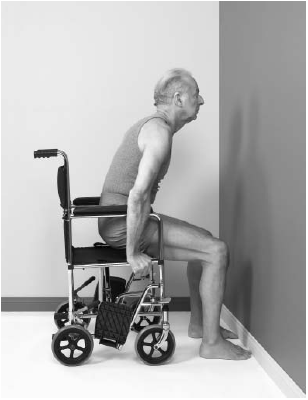
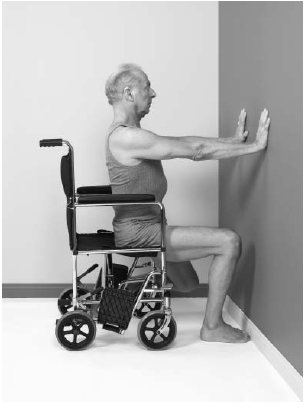
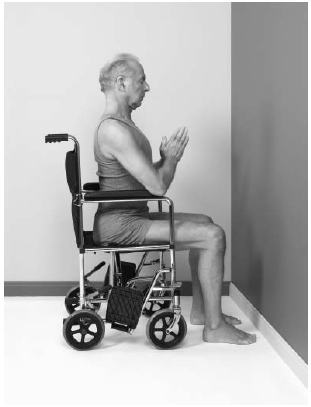
14. Breathe smoothly, lift the back waist, and try to inhale into the sides of your chest. On the exhalation, place your hands on top of the knees, and press the elbows forward, still resting your forehead against the wall.
15. Bring the arms down, lean forward, and rest your head on the wall.
16. Drop the arms down, place your hands on the floor, either outside the feet or between the feet, depending on your flexibility. On an inhalation, sit up and return to the first position, with hands resting in front of the heart, palms together.
17. Sit quietly, observe your breath and the balance of the body, and observe any changes in the spinal column, chest position, and softness of the shoulder girdle. Allow the eyes to gaze forward, releasing any tension in the forehead or temples. This asana can be repeated, starting by moving the left leg back first.
This asana energizes and also calms the nervous system, depending on the intent of the practice. It increases flexibility, range of motion, and circulation of the limbs, particularly the legs. When you sit for a long time with little or no movement, blood tends to pool in the lower limbs, causing edema and hemostasis. This series helps reduce the swelling of the lower limbs, improves digestion, helps elimination become regular, and improves the volume, timing, and placement of the breath. It engenders a general feeling of contentment and accomplishment.
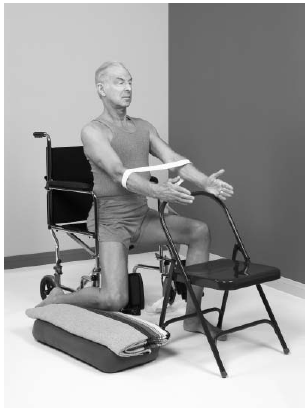
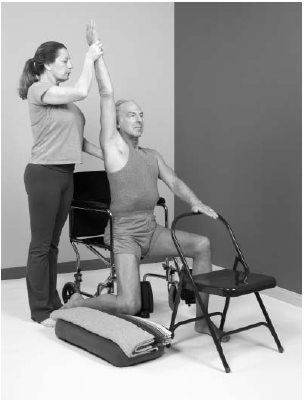
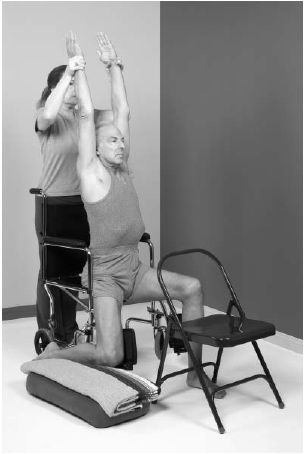
Warrior Pose I
1. Sit upright in your chair, with the back of your torso away from the support of the chair. Place both feet directly under your knees, feet facing straight ahead.
2. Place a chair in front of your knees, with the seat facing forward.
3. Place a strap around the arms, just above the elbows, with the buckle away from your arms.
4. Move the hips to the right, raising the right buttock slightly off the seat of the chair.
5. Then draw the right leg back, using your hands if necessary, and drop the right knee toward the floor, as much in line with the hip as possible.
6. If the knee does not touch the floor, then place a folded blanket under the knee to stabilize the posture.
7. Rest the outside of the palms on the top of the chair. On an inhalation, lift the back waist together with the sternum.
8. Raise the arms up until they are even with the ears, if possible. Hold the position for 3 inhalations and exhalations, and then lower your arms. If using an assistant, raise one arm at a time.
Note that the assistant is encircling the wrist with a thumb and forefinger, thus enabling the student to extend the rib cage. Press the sit bones deeper into the chair, stretching the middle back muscles to counteract the effects of sitting for long periods of time with a soft, rounded back support. Flexing the knee on a folded blanket encourages additional blood flow into the pelvic cavity.
9. Return to the original sitting position with an exhalation, sit quietly for a few moments, and then repeat to the other side.
10. After completing the asana to both sides, remain sitting as much as possible away from the back of the chair.
The pose helps to develop deeper breathing by expanding the chest. It relieves stiffness in shoulders, neck, back. hips, and knees, and strengthens ankles and knees. In most instances, it improves the sense of balance and builds stamina in the legs and arms.
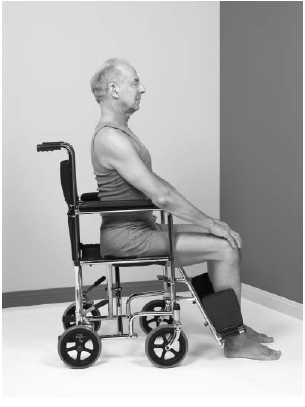
WHEELCHAIR UTTHITA TRIKONASANA I
Extended Triangle Pose I
1. Place a folding chair to the right side of your wheelchair, and fasten a safety belt around your waist. Position a folded sticky mat with the folded edge even with the edge of the folding chair seat.
2. Bring your right leg to the right side of the wheelchair, with your foot as flat to the floor as possible. Move your left leg to the left as much as the chair allows.
3. Move your hips to the left as much as possible, and lean over and place the right elbow on the sticky mat.
4. Place your left hand on your hip, and drop the elbow backward, to open the chest cavity. Breathe into the upper ribs and chest area.
Do not distort the ribs in order to place the right elbow, instead use blankets under the elbow to maintain the alignment of the spine and rib cage. Take a few breaths. With an inhalation, raise the left arm parallel to the right arm.
5. Hold the position for 3 to 5 breaths. Then, retaining the left hand and arm firmly aloft and to the left, press up into a sitting position. Remain seated quietly before repeating to the left.
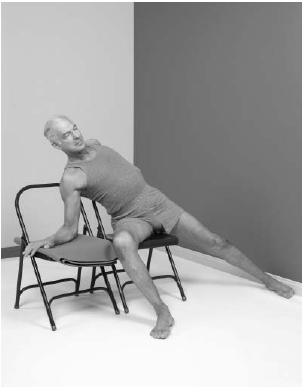
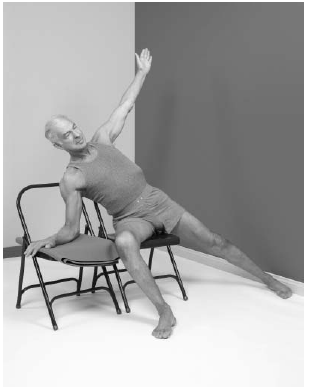
WHEELCHAIR UTTHITA TRIKONASANA II
Extended Triangle Pose II
1. Sitting upright in the wheelchair with a safety belt around the waist, bring a second folding chair to your right side.
2. Bring the right leg to the right side of the wheelchair, as far as is comfortable, with the foot flat on the floor.
3. Move the left leg to the left as much as is allowed by the chair. Move the hips to the left as much as possible. Lean over and place the right hand on the bar of the front legs of the folding chair. Do not distort the ribs in order to place the right hand.
4. Place your left hand on the left hip, and drop the elbow backward, to open the chest cavity. Breathe into the upper ribs and chest area. Take a few breaths.
5. With an inhalation, raise the left arm parallel to the right arm. Hold the position for 3 to 5 breaths. Then maintaining the left hand and arm firmly to the left, press up into a sitting position. Remain seated quietly before repeating on the left.
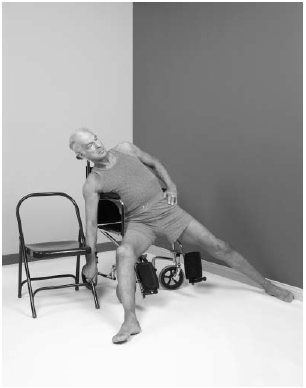
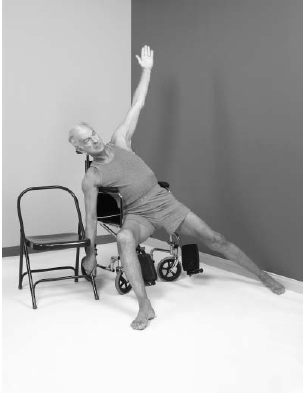
Both versions of Extended Triangle Pose create a dynamic change in circulation in both the pelvis and the torso. The kidney functions are stimulated, together with the digestive system and the elimination process. Tension in the spinal column and surrounding muscles is reduced. The lower back and pelvis are realigned, thereby counteracting the pose is to completely enhance the breathings of long periods of sitting. The pose revitalizes the ligaments and tendons and tones the leg muscles.
Wheelchair Backbend
1. To start, roll a sticky mat into a tight roll. This can be achieved by opening the sticky mat, folding over one end about a foot, then rolling the mat very tightly.
2. Sit up as much as possible away from the back of the wheelchair. The buttocks should be in the middle of the seat.
3. Lean back to make sure that the bottom edges of the shoulder blades can be supported against the back of the chair. Then sit up again and insert the rolled sticky mat behind you. parallel to the spine, supporting the neck and the back of the head.
4. Press your feet into the wall, with the heels 3 inches away from the wall and the toes up on the wall, with slightly bent knees.
5. Interlock your fingers firmly in front of you, and if possible place the hands behind your neck, with the little finger on the occipital bone and the thumbs coming around to the sides of the throat and resting on the collarbones.
6. Bring your elbows close to your ears and point them up to the ceiling.
7. Allow the head to rest in the palms, as you press the feet into the wall.
8. Gently release the head into the hands, with the sticky mat supporting the neck and back of the skull.
9. Let your eyes settle gently into the cheekbones; the tongue should not press on the upper palate or the lower jaw. Breathe gently, allowing the breath to move up into the chest cavity. After 3 to 5 breaths, bring the head up first on the inhalation.
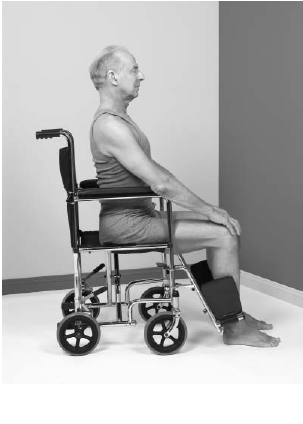
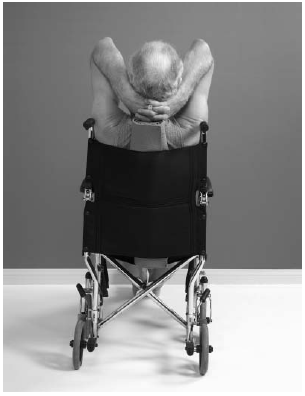
10. Then stretch the arms up and forward. Sit quietly, allowing the breath to rise into the chest.
Notice that the assistant has braced one leg on the bottom edge of the seat of the chair, placing the knee gently into the mid-back. Her hands are on the elbows, with thumbs rotating the bicep outward, and lightly lifting the arms up parallel to the ears.
Caution:Do not grip or tighten the throat.
Here the knees are bent. If extending the legs is a challenge, keep the feet under the knees as much as possible.
This pose greatly relieves lower back issues. The diaphragm is freed from the constant pressure of resting against the abdominal organs. Digestion is improved by realigning and gently stretching the intestinal tract. And as digestion improves,
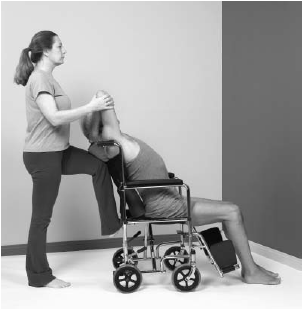
so does elimination. The pose benefits the chest area by correcting the forward slump of the shoulders. Neck and shoulder discomfort is reduced. It is recommended that seated twists follow the backbends.
Wheelchair Seated Twists
1. Begin by placing a folding chair in front of your wheelchair, with the seat facing right. Then rest the right leg on the chair. If this causes any discomfort at the knee, place a rolled sticky mat or towel under the knee to release the hamstrings. If the leg is long, two chairs will be necessary, so the foot does not hang.
2. Then lift the left leg, resting the left foot on the seat of the chair.
3. Turn the navel toward the back of the folding chair, allowing the right hand to follow and clasp the back of the chair. Press the left leg into the back of the folding chair.
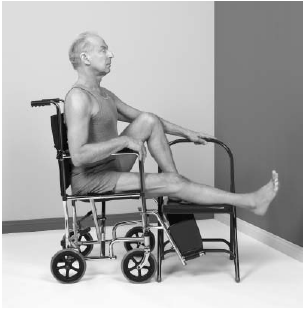
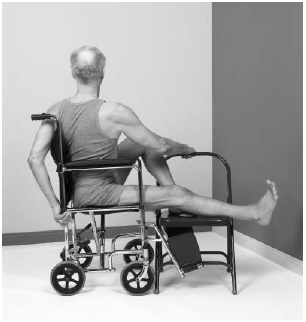
4. With another exhalation, take the left hand around to the back of the wheelchair, so the top of the wheelchair is under the armpit, supporting the ribs.
5. Release and lower the shoulders away from the ears, and keep the nose in line with the heart.
6. Press down into the left foot, extend the right foot away from the right hip, and breathe in a smooth and easy manner, keeping the chest lifted and the shoulders back.
7. Release the right arm first, then the left arm.
8. Take each leg to the floor, and sit quietly. Then turn the folding chair in the opposite direction, and repeat to the other side
This pose stimulates all the organs in the torso to improve their function. Sitting posture is improved, flexibility in the hips and legs is enhanced, and leg cramps are reduced. Tension in shoulders and neck is lessened, resulting in fewer headaches.
Wheelchair Twist with Bolster
1. Begin by securing the safety belt. Bring the feet under the knees. If the leg is long, place a folded blanket under the buttocks. If the leg is short, place a folded blanket under the feet.
2. Place a bolster or folded blankets on top of the thighs. This is important if the student is full-figured or has a limited range of motion, so as to not cramp or pinch the organs in the torso or pelvis.
3. Sit up, turn toward the bolster, and grasp the side of the wheelchair with the right hand in order to maintain balance.
4. Raise the left arm up level with the ear, and press the sit bones down into the chair seat.
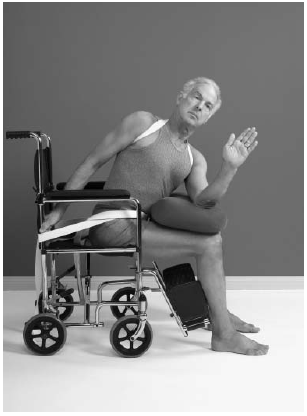
5. Lift the rib cage, turn the navel toward the bolster, and bring the left elbow to the top of the bolster, as close to the right side as possible.
6. Keep your head in line with the spine, and try not to tighten the throat.
7. Extend the fingers of your left hand as if pressing against a wall, and breathe smoothly and evenly for 3 to 5 breaths.
8. Return the arm to the level of the left ear on the inhalation, bring the arm down on the exhalation, and sit quietly for 10 to 20 seconds. Then repeat on the other side.
Note that the left ear is more in line with the left leg, rather than leaning to the right or looking down or back. This ensures that the muscles of the mid and lower back are not strained.
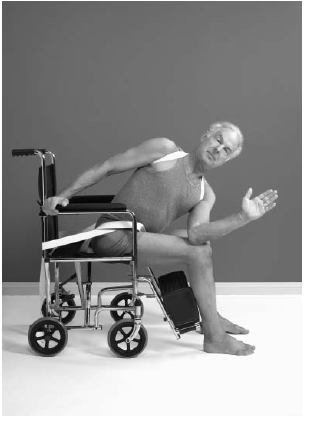
This pose is excellent for the digestion. It relieves lower back discomfort from sitting for extended periods of time, aids elimination, and reduces constipation. It increases flexibility in the hip joints and increases circulation in the torso, pelvis, and limbs.
Cobbler’s Pose
1. Secure the safety belt and lock the wheels of the wheelchair. Place a folding chair with the seat facing the wheelchair.
If your range of movement is limited, turn the chair around so the back of the chair can act as a support, and place a folded sticky mat on the seat.
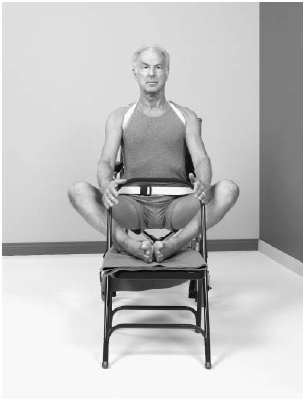
2. Raise the legs by holding behind the knee and relaxing the adductor muscles.
3. Place the feet together, with the toes and heels touching if possible.
If there is undue pressure in the groins, support the outer knee with the back of a chair placed under the leg.
4. Sit up away from the back of the wheelchair. If that presents a problem, place a rolled sticky mat, a folded blanket, or a block between the chair back and the mid back, behind the heart area.
5. Lift the rib cage and side chest with an inhalation, and exhale behind the navel. A strap can be looped around the back of the folding chair to facilitate lifting the torso. Hold the position for 10 breaths or whatever is comfortable.
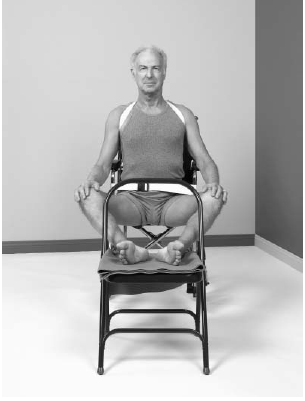
6. Use your hands on the outer side of the knees to lift the legs up and together, slowly and carefully.
8. Then place your hands behind your knees, and draw the flesh of the knee back toward the hips as the legs stretch forward to rest on the seat of the chair.
9. Bring legs down. Sit quietly with both feet on the floor.
WHEELCHAIR PREPARATION FOR JANU SIRSASANA
Preparation for Head-to-the-Knee Pose
1. Sit up away from the back of the wheel-chair, using a prop if necessary to support the torso.
2. Place the folding chair in front, with the seat facing toward the wheelchair. Please note that a strap has been placed around the shoulders and over the back of the neck, like a harness.
The buckle is in the middle of the back, and the tail of the strap can be used to tighten the strap in order to hold the shoulders back to improve the posture and strengthen the torso. This device can be used in many asanas throughout the book to enhance the posture and develop an awareness of alignment.
3. Loop a strap around the back of the folding chair, and with a moderate pull, sit up as tall as possible.
4. Encourage the inhalation to lift the ribs and side chest, lowering the shoulders away from the ears. If there is increased pressure behind the knee, use a rolled towel or sticky mat to reduce any tension.
Head-to-the-Knee Pose
1. Begin by locking the wheels of the chair. Place a folding chair in front, with the seat facing toward you.
2. Place a folded blanket on the seat of the chair. Bring a second folding chair to the right side.
3. Bending the right leg and placing the right foot against the left thigh, support the right leg with additional folded blankets.
4. Loop a strap around the left foot or the back of the first chair. Holding the strap in each hand, raise the torso away from the back of the wheelchair.
5. Raise the rib cage, lift the bottom edge of the sternum, and press the buttocks back and down into the seat.
6. Gently turn the navel toward the left leg without distorting the neck or head. Hold the position for at least 5 even breaths and then release.
7. Use the right hand outside the right knee to bring the right knee up.
8. Place both hands behind the right knee and stretch the right leg forward, placing it on the seat of the chair next to the left leg.
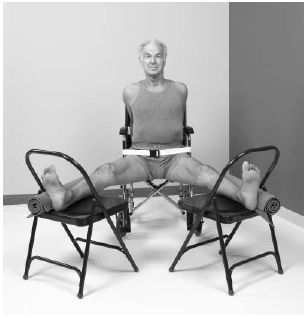
9. Bring the second chair with the folded blankets to the other side, and repeat the asana on the other side.
This asana is a combination of Baddha Konasana, Paschimottanasana, and the seated twists. It greatly enhances digestion, elimination, flexibility of legs and arms, and it releases tension in the shoulders, neck, and spine. It tones the legs and arms and lengthens the hamstrings.
Seated Wide Angle Pose
1. Begin by securing the safety belt and locking the wheels.
2. Bring two folding chairs in front and to the side of the wheelchair, with the seats facing toward you.
3. Place the legs on the chair, with the back supports of the chair bracing the legs.
4. Place a rolled sticky mat between the chair and the legs, which helps to keep the legs and feet in alignment. Notice that the feet are pointing up as much as possible, and the inner knees are turning toward the seat of the chair.
5. Bring the back of the torso away from the back of the chair, using props if necessary. Sit on the tips of the sit bones, bracing your hands behind you.
6. Bring the breath into the side chest, press down on the hands, and lift the side chest as much as possible.
7. Remain in the posture for 5 to 10 breaths.
8. Return to center by bringing the chairs together slowly and carefully with your hands, and remain seated with the legs stretched forward supported on the chairs. Sit quietly and breathe.
This pose will open the groins, increase circulation in the lower pelvis, and increase flexibility in the hips, adductors, and ham-strings. It reduces tension in the mid and lower spine and generally tones the legs and arms. Additional blood circulation in the hip joints strengthens the joints and reduces the brittleness and dryness of the bone, which can lead to spontaneous fracture.
Forward Bend Pose
1. Begin by securing the seat belt, with enough slack to be able to bend forward. Lock the wheels. If necessary, use the shoulder harness, as illustrated.
2. Place a bolster between the feet, toes forward, ankles braced by the sides of the bolster.
3. Sit up and with a few breaths align your head with the center of the pelvis.
4. Place the hands palm down on top of the knees and lean forward 30 degrees.
5. Slip the hands down the inside of the legs to the mid calf, and lean forward 60 degrees.
6. Keep the head in line with the spine, and with an exhalation, place the palms down onto the bolster between the legs, if possible.
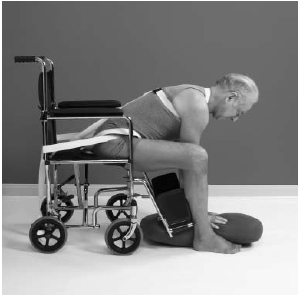
7. Then gently press the knees against the outer upper arm and the arms against the inside of the knees. This action releases tension in the lower spine and hips.
8. If there is any difficulty maintaining the head in line with the spine, a second chair can be placed under the head, with folded blankets or bolsters on the seat to support the head. Only the forehead rests on the support, so that the nose is free from pressure. Allow the eyes to rest against the cheekbones.
9. Hold for at least 30 seconds to 1 minute to start, and then build up to 2 minutes.
10. Return to a sitting position by keeping the head down and placing the hands on top of the knees, hold for several breaths, then use the hands to press up slowly on the count of 10 to a sitting position.
11. Sit quietly for 10 to 20 breaths.
This pose irrigates the kidneys, liver and may reduce discomfort in the stomach . The heartbeat slows, and the spinal nerves are
rejuvenated. The pose counters depression, and students that are easily excited often become calm and cool, with a sense of well-being. Vision often improves.
Supported Boat Pose
Note: This asana is not to be done without at least three months of prior practice.
Then it is usually performed toward the end of a practice or class session.
1. Begin with the safety belt secured. Lock the wheels. Bring a folding chair in front, with the seat facing you.
2. Place a folded sticky mat on the seat of the second chair. A blanket can be folded over the back of the wheelchair for comfort.
3. Lift both feet onto the edge of the folding chair, and place the bolster at the angle illustrated.
4. Extend the legs up toward the back of the folding chair, clasping a strap in each hand that has been placed midway on the back of the chair around the bolster. The bolster can be placed flat on the seat to accommodate those who are tight in the hamstrings or have a balance problem.
5. Raise the chest and side ribs. Keep the head parallel to the spine, and breathe easily.
6. Try not to hold the breath. If there is undue stiffness in the neck and shoulders, the wheel chair can be moved next to a wall and the back of the head will be supported.
7. Hold the posture for at least 10 breaths. 8. Release the strap, bend the knees, and rest the feet on the edge of the chair seat.
9. Lower the legs to the floor with manual support behind the knees to keep the groins soft.
10. Walk your hands bent to your sides. Return to a sitting position.
This pose is very beneficial to the liver, gall bladder, and spleen. It strengthens the back muscles, which become flaccid due to the shape of the wheelchair and prolonged sitting. It opposes lumbar osteoporosis.
Relaxation Pose
1. Place a folding chair in front of the wheelchair and facing it. Put a folded sticky mat on the seat.
2. Rest one end of a bolster against the back of the folding chair, and place the other end in your lap or on your thighs.
3. Lean forward to rest the head face down, with a towel or blanket supporting the forehead, allowing the nose to be free from any pressure.
4. If possible, cross your arms over your head while it rests on the bolster. If it is difficult to rest your head on the bolster, then use folded blankets or another bolster to allow greater comfort. The arms can also rest on the seat of the chair if it is difficult to raise them over your head.
5. Allow the eyes to rest into the cheekbones, and release the tongue away from the upper and the lower palate.
6. Allow the breath to be smooth and even. Try to stay focused on the breath. It is natural to let the thoughts wander into the past, into the future, or to take in the events of the day. Part of Savasana is to learn to be in the moment.
This is also the time when the pose is to completely enhance the breathings of yoga practice can be absorbed into the conscious mind. When it becomes difficult to remain in the rhythm of the breath, then it is time to begin slowly rising up from the support of the bolster.
7. Lift the head from the chest. Open the eyes on an inhalation.